冀教版七年级上Lesson33教学设计
冀教版七年级上lesson33教案
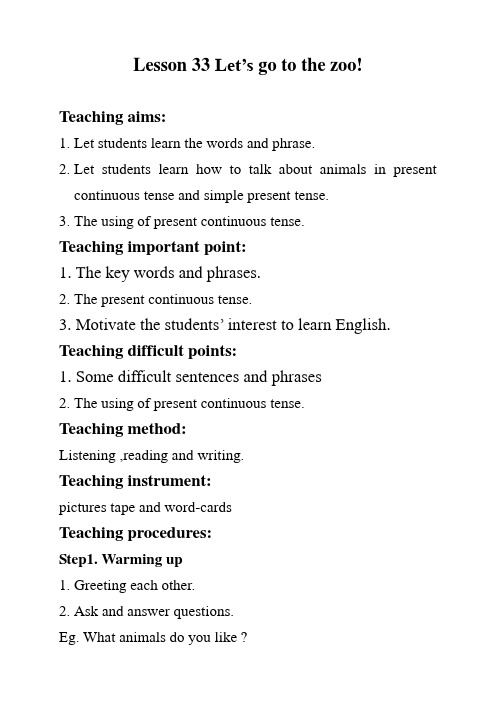
Lesson 33 Let’s go to the zoo!Teaching aims:1.Let students learn the words and phrase.2.Let students learn how to talk about animals in present continuous tense and simple present tense.3.The using of present continuous tense.Teaching important point:1. The key words and phrases.2.The present continuous tense.3. Motivate the students’ interest to learn English. Teaching difficult points:1. Some difficult sentences and phrases2.The using of present continuous tense.Teaching method:Listening ,reading and writing.Teaching instrument:pictures tape and word-cardsTeaching procedures:Step1. Warming up1.Greeting each other.2.Ask and answer questions.Eg. What animals do you like ?Step2. presentationShow the pictures and introduce the words: zoo, lion, tiger, elephant and monkey. Then write them on the blackboard, students read after teacher.Step3. ListeningLet students listen to the tape and fill in the blanks.Step4. ReadingLet students read the text in roles.Step5. Language pointsStep6. PracticeDiscuss: What animals can you see in the zoo?Then look at the pictures again “What’s this?What’s it doing? What’s it eating?1. What are they doing?2. The monkeys is eating….Step7. Exercises1. make a dialogue like thisA: What’s your favourite animal?B: My favourite animal is……A: What does it eat?B: It eats……A: Where does it live?B: It lives……2. 用所给词的适当形式填空1. There are some _____ (monkey) in the zoo.2. Tigers _____ (eat) meat now.3. An elephant _____ (have) a long nose.4. The lion ______ (sleep) in the cage.5. He and I don’t _____ (like) apples.Step8. HomeworkWrite your favourite animal。
冀教版英语七年级上册Lesson 33教案
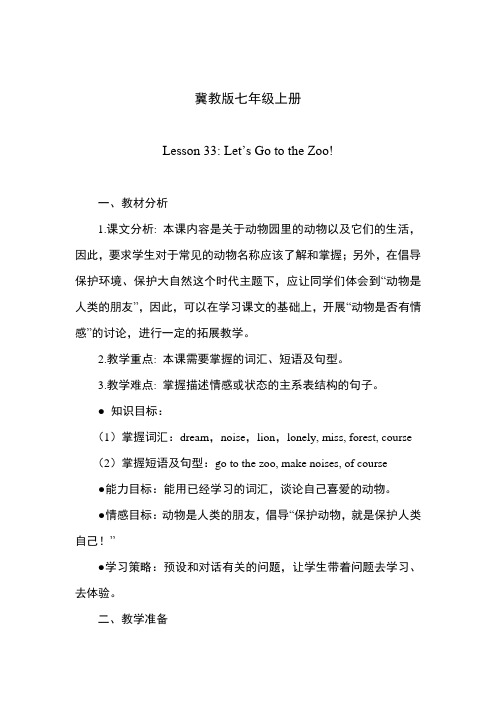
冀教版七年级上册Lesson 33: Let’s Go to the Zoo!一、教材分析1.课文分析: 本课内容是关于动物园里的动物以及它们的生活,因此,要求学生对于常见的动物名称应该了解和掌握;另外,在倡导保护环境、保护大自然这个时代主题下,应让同学们体会到“动物是人类的朋友”,因此,可以在学习课文的基础上,开展“动物是否有情感”的讨论,进行一定的拓展教学。
2.教学重点: 本课需要掌握的词汇、短语及句型。
3.教学难点: 掌握描述情感或状态的主系表结构的句子。
● 知识目标:(1)掌握词汇:dream,noise,lion,lonely, miss, forest, course (2)掌握短语及句型:go to the zoo, make noises, of course●能力目标:能用已经学习的词汇,谈论自己喜爱的动物。
●情感目标:动物是人类的朋友,倡导“保护动物,就是保护人类自己!”●学习策略:预设和对话有关的问题,让学生带着问题去学习、去体验。
二、教学准备1. CAI课件;2. pictures of animals三、教学步骤Step Ⅰ. Class Opening (3 minutes)T:Boys and girls, do you know a saying like this:When the cat is away, mice will play. Who can translate it into Chinese? Yes, “山中无老虎,猴子称霸王。
” Where can you find them? Yes, let’s go to the zoo! Then show the title “Lesson 33:Let’s Go to the Zoo!” on the screen. 再采用超链接播放一段关于动物园内各种动物活动的视频。
[设计思路:“山中无老虎,猴子称霸王。
冀教版英语七上Unit 6《Lesson 33 Let’s Go to the Zoo!》教学设计

冀教版英语七上Unit 6《Lesson 33 Let’s Go to the Zoo!》教学设计一. 教材分析冀教版英语七上Unit 6《Lesson 33 Let’s Go to the Zoo!》是一篇关于动物的课文,主要介绍了各种动物的特点。
本课内容与学生的生活息息相关,有利于激发学生的学习兴趣。
教材通过生动的图片和简单的句子,帮助学生掌握动物的英文名称和特点。
此外,本课还涉及了一般现在时的用法,为学生进一步学习英语语法打下基础。
二. 学情分析七年级的学生已经掌握了基本的英语语法和词汇,对学习英语有了初步的认识。
但部分学生对动物的英文名称和特点了解不多,学习过程中可能存在一定的困难。
此外,学生之间的英语水平参差不齐,教学过程中需要关注全体学生,尽量让每个学生都能参与到课堂活动中来。
三. 教学目标1.知识目标:学生能够掌握动物的英文名称和特点,正确运用一般现在时描述动物的特点。
2.能力目标:学生能够听懂、会说、会读本课的生词和句子,提高口语表达能力。
3.情感目标:学生能够热爱大自然,关心动物,培养保护动物的意识。
四. 教学重难点1.重点:动物的英文名称和特点,一般现在时的用法。
2.难点:一般现在时的句子结构,动物特点的描述。
五. 教学方法1.情境教学法:通过图片、视频等直观手段,创设生动有趣的情境,激发学生的学习兴趣。
2.任务型教学法:引导学生参与各种任务,提高学生的实践能力和合作精神。
3.游戏教学法:通过趣味游戏,巩固所学知识,提高学生的口语表达能力。
六. 教学准备1.教学课件:制作包含图片、视频、动画等元素的课件,辅助教学。
2.教学卡片:准备动物的英文名称和特点的卡片,用于课堂操练。
3.动物园场景:布置一个动物园的场景,增加课堂趣味性。
七. 教学过程1.导入(5分钟)利用课件展示各种动物的图片,引导学生说出动物的名称。
然后提问:“你们去过动物园吗?最喜欢哪种动物?”激发学生的兴趣。
2.呈现(5分钟)播放课文动画,让学生跟随课文一起朗读。
冀教版七年级英语上册Lesson33Let’sGototheZoo!教学设计
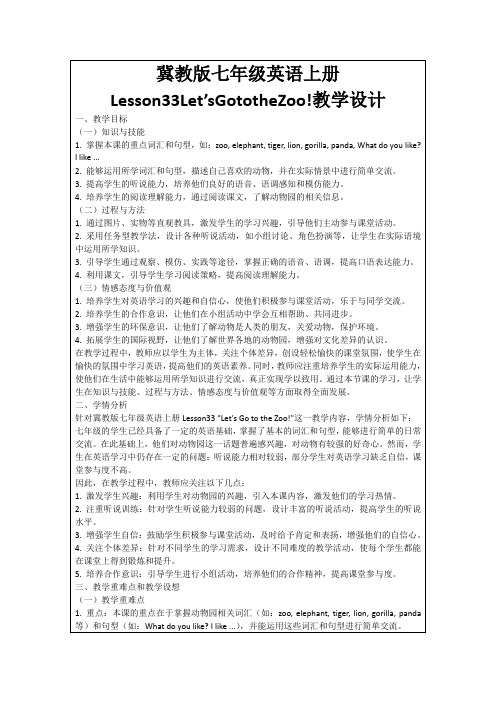
4.写作任务:请学生写一篇关于他们最喜欢的动物的短文,描述该动物的外貌、习性及喜好。要求使用一般现在时态,不少于50词。
5.观察与思考:观察身边的动物,了解它们的生活习性和生活环境。思考如何保护动物,保护生态环境。
3.阅读练习:阅读课文,回答课后问题,提高学生的阅读理解能力。
4.写作练习:让学生写一篇小作文,描述他们最喜欢的动物及其特点。
(五)总结归纳,500字
在课堂的最后阶段,教师邀请学生回顾本节课所学内容,总结动物园的相关词汇和句型。教师提问:“What have we learned today?”,引导学生回答。
4组内用所学词汇和句型进行问答,互相了解对方的喜好。
-教师巡回指导,及时纠正学生的语言错误,并提供帮助。
5.课堂巩固:
-通过听力练习和阅读课文,巩固所学词汇和句型,提高学生的听说读写综合能力。
-设计一些小型的写作任务,如写一段关于自己最喜欢的动物的简短描述,以巩固动词的一般现在时态。
(二)讲授新知,500字
在讲授新知环节,教师首先通过呈现句型卡片,引导学生学习句型:“What do you like? I like ...”。教师邀请几名学生进行示范,让其他学生模仿并练习。然后,教师通过图片、实物等教具,帮助学生理解并记忆新词汇。
(三)学生小组讨论,500字
在学生掌握基本句型和词汇后,教师组织学生进行小组讨论。每个小组选择一个动物园主题,讨论以下问题:“What animals can you see in the zoo? What do they look like? What do they like to eat?”等。小组成员分别扮演不同的角色,如:导游、游客等,用所学英语进行交流。
(新)冀教版七年级上册Lesson 33(公开课)教学设计
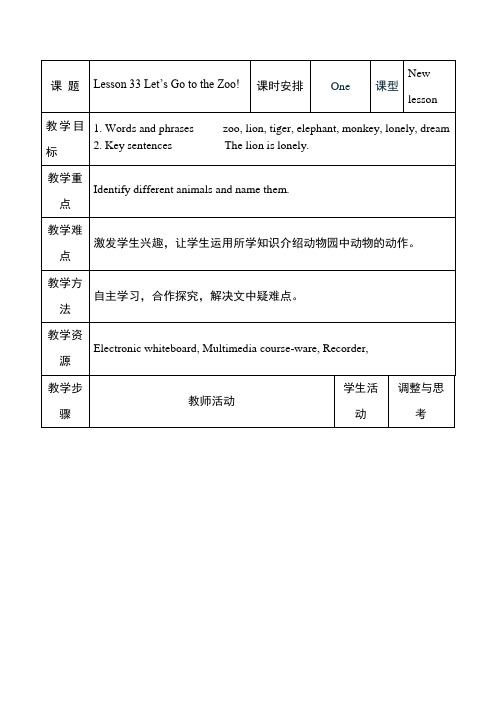
第二课时一、概述本课是冀教版第三册第六单元的第六课。
本课的话题依然是未来的交通工具,角度更多,着眼点更丰富。
本课是由两封电子邮件组成的,讲的是Brian和Jenny谈论各自身边发生的关于“未来的交通工具创造〞这一话题的内容。
通过本课学习可以帮助学生更完整、更全面地用英语介绍他们的创造。
我在授课开始时先出示了Danny的“会飞的面包圈〞这一创造,引出本课话题。
接着顺着这条线,引入新课,谈及了Jenny创造环保汽车的想法。
之后,以图片加解释相结合的形式呈现了本课的单词、短语和句子。
接着,通过设计听录音做选择,读课文并答复以下问题的环节完成了课文内容的讲授。
本课内容较为简单,词汇量不大,为了帮助学生扩大信息量,我设置了一篇拓展阅读。
我还引导学生从优缺点两方面进一步介绍他们的创造,最后完成英语写作任务。
二、教学目标1.知识与技能(1)掌握词汇及短语:than, from now on, think of, jump down。
(2)能够运用所学知识描述感兴趣的未来交通工具的创造,训练学生听说读写的技能。
2.过程与方法(1)能够通过师生、生生交流和自主听读体验交际式英语教学的一般过程,掌握英语听说读写的根本方法;(2)能够通过小组口语交流,体验合作学习的过程和方法;3.情感态度与价值观鼓励学生思想创新,积极表现自己,培养学生学习英语的自信,保持学习英语的兴趣。
三、教学资源1.冀教版八年级英语教材2.络资源;配套教学光盘四、教学重点:能够运用所学知识描述感兴趣的未来交通工具的创造,训练学生听说读写的技能。
五、教学难点:帮助指导学生从优缺点两方面进一步介绍他们的创造,最后完成英语写作任务。
六、教学过程Class opening 〔3minutes〕T: Good morning, class. Have you remembered Danny’s invention? What is it? PPT呈现出图片,谈论这个创造,并以此导入本节新课。
Unit6Lesson33LetGototheZoo教学设计2023-2024学年冀教版英语七年级上

冀教版七年级上学期unit 6 Lesson 33 Let’s Go to the Zoo!教学设计Step 1.GreetingGreet the students: Good morning, boys and girls.Step 2ReviewAt the supermarketA:Can I help you?B: Yes, I’d like to buy…,Where are they?A: They are …B:How much…A:They are…B:Okay, I’ll take it.Step 3 Warming upWhat can you see in the zoo?Show stuents some pictures about animals.Then ask them what it is doing.The monkey are eating bananas. The lions are sleeping.The tiger are walking.The birds are singing.The panda is eating bamboo.(竹子)2.Read and answer2.Read the lesson and circle the correct words.1.The tiger is(hungry/tired/sad).2.The lion is(lonely/sick/hungry).3.The panda is(lonely/happy/cute).4.The birds are(quiet/happy/hungry).5.The elephant is(eating/dreaming/singing)Step 6 PresentationListen to the lesson again and repeat.Danny:Look,Jenny!Monkeys!Are they eating donuts?Jenny:No,they aren’t. They are eating bananas. Danny:Wow!Can you see the panda,Jenny?Jenny:Oh,I see him. He looks cute.Danny:Look over there!The tiger is eating meat. He is hungry.Jenny:Yes,he is!Do you see the elephant?Danny:I see him!Is he sleeping?Jenny:Yes. He is dreaming.Jenny:See those birds?Danny:Yes. I see them. They are making noises. Jenny:They are singing,Danny. They are happy!Danny:Look at the lion!Is he sad?He looks lonely!Jenny:Maybe he is missing the forest.Step 7 Language points1.He is dreaming.dream /driːm/ v. 做梦;梦想n. 梦;梦想(1)dream about/of (doing) sth.意为“梦想/ 梦见(做)某事”。
冀教版-英语-七上-6单元 第33课教学设计
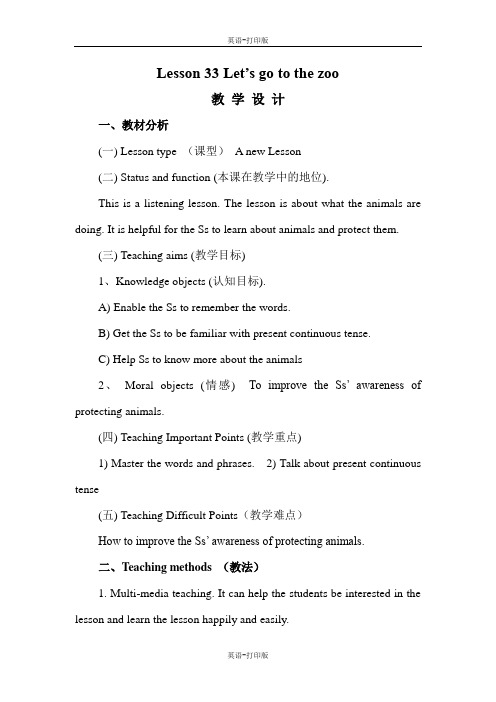
Lesson 33 Let’s go to the zoo教学设计一、教材分析(一) Lesson type (课型)A new Lesson(二) Status and function (本课在教学中的地位).This is a listening lesson. The lesson is about what the animals are doing. It is helpful for the Ss to learn about animals and protect them.(三) Teaching aims (教学目标)1、Knowledge objects (认知目标).A) Enable the Ss to remember the words.B) Get the Ss to be familiar with present continuous tense.C) Help Ss to know more about the animals2、Moral objects (情感) To improve the Ss’ awareness of protecting animals.(四) Teaching Important Points (教学重点)1) Master the words and phrases. 2) Talk about present continuous tense(五) Teaching Difficult Points(教学难点)How to improve the Ss’ awareness of protecting animals.二、Teaching methods (教法)1. Multi-media teaching. It can help the students be interested in the lesson and learn the lesson happily and easily.2、Encouragement and praise.三、Learning methods (学法).1. Teach Ss how to be successful language learners.2. Get the Ss to form good learning habits.四、Teaching Aids(教具)Multi-media computer, PPT, a tape recorder五、Analysis of the students (学生分析)The students are in Grade Seven now, and they have some interests of learning and speaking English, they are willing to co-operate and communicate with others in class, especially this lesson is related to their daily life. I think it’s easy for them to learn the lesson and they will take an active part in the activities in class.六、Teaching procedures(教学过程)Step I. Greetings.Step II. Warm up Ask some students “the weather” and review the last lesson.Step III. Leading in.Today they want to see some animals, where can they go? (边说边展示图片) Let the students to realize some animals.设计意图:通过图片导入,激发学生兴趣,快速进入文章。
冀教初中英语七上《Lesson 33 Let's Go to the Zoo!》word教案 (2)

Lesson 33: Let’s Go to the Zoo!一、教材分析1.课文分析: 本课内容是关于动物园里的动物以及它们的生活,因此,要求学生对于常见的动物名称应该了解和掌握;另外,在倡导保护环境、保护大自然这个时代主题下,应让同学们体会到“动物是人类的朋友”,因此,可以在学习课文的基础上,开展“动物是否有情感”的讨论,进行一定的拓展教学。
2.教学重点:本课需要掌握的词汇、短语及句型。
3.教学难点: 掌握描述情感或状态的主系表结构的句子。
●知识目标:(1)掌握词汇:dream,noise,lion,lonely, miss, forest, course(2)掌握短语及句型:go to the zoo, make noises, of course●能力目标:能用已经学习的词汇,谈论自己喜爱的动物。
●情感目标:动物是人类的朋友,倡导“保护动物,就是保护人类自己!”●学习策略:预设和对话有关的问题,让学生带着问题去学习、去体验。
二、教学准备1. CAI课件;2. pictures of animals三、教学步骤Step Ⅰ. Class Opening (3 minutes)T:Boys and girls, do you know a saying like this:When the cat is away, mice will play. Who can translate it into Chinese? Yes, “山中无老虎,猴子称霸王。
”Where can you find them? Yes, let’s go to the zoo! Then show the title “Lesson 33: Let’s Go to the Zoo!” on the screen. 再采用超链接播放一段关于动物园内各种动物活动的视频。
[设计思路:“山中无老虎,猴子称霸王。
”这种以谚语导入新课的方式形式新颖,与新课内容衔接自然;同时,又能让同学们体会到因文化差异而产生的语言的趣味性。
教版七年级英语上lesson33Let’sgotothezoo教案
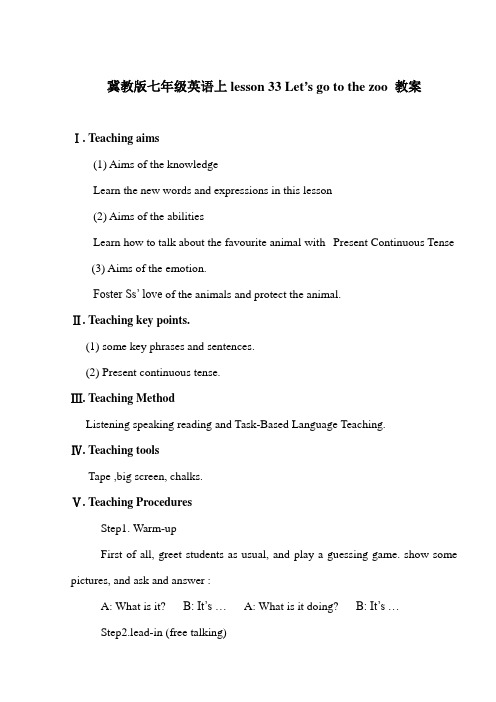
冀教版七年级英语上lesson 33 Let’s go to the zoo 教案Ⅰ. Teaching aims(1) Aims of the knowledgeLearn the new words and expressions in this lesson(2) Aims of the abilitiesLearn how to talk about the favourite animal with Present Continuous Tense(3) Aims of the emotion.Foster Ss’ love of the animals and protect the animal.Ⅱ. Teaching key points.(1) some key phrases and sentences.(2) Present continuous tense.Ⅲ. Teaching MethodListening speaking reading and Task-Based Language Teaching.Ⅳ. Teaching toolsTape ,big screen, chalks.Ⅴ. Teaching ProceduresStep1. Warm-upFirst of all, greet students as usual, and play a guessing game. show some pictures, and ask and answer :A: What is it? B: It’s …A: What is it doing? B: It’s …Step2.lead-in (free talking)Tell students: just now, we saw lots of animals, where can you see so many animals,when you see the zoo,T: Do you think they are happy, S: No,T: Why do you think so?Please talk: Does animals have feelings? Which is a better place for animals, the zoo or the forest?Step3. show the studying aim. And let’s student read them in Chinese.Step4. learn some new words.Show some new words in lesson33,and make sure the students can understand them.Step5. listening.In this class, Danny and jenny will go to the zoo. now let’s listen a dialogue about animals. please look some pictures ,answer me what are they? Listen two times and circle the correct pictures.Step6. ReadingPlease read Danny and jenny’s dialogue loudly first time,Please read Danny and jenny’s dialogue again, and do the part 2 in let’s do it.Step7.key pointsLet’s students read the dialogue in roles ,Then translate it into Chinese, and make students find some key points.Then T: Do you have any other questions? and let students find the key points by themselves.1、V oice, sound 与noise的区别2、Lonely与alone的用法区别Step8. Do some exerciseWe can use Present Continuous Tense and Simple present tense to finish them.Step9.review what we learnt in this class.Ⅵ.Homework1、Where do animals like to live?In the zoo or in the forest? Write a short passage about the two questions.2、To preview Lesson 34:On the Farm!To read the new words in Lesson 34 Ⅶ. blackboard designLesson 33 let’s go to the zoo看起来孤独当然制造噪音去动物园miss the forest look cute1、V oice, sound 与noise的区别2、Lonely与alone的用法区别课后反思:本文通过让我们去动物园引出相关动物的一些单词以及动物们正在做什么事情来学习现在实行时态的用法。
冀教版英语七年级上册Unit6Lesson33LetGototheZoo教学设计

3.听力技能的提升:本节课的听力活动旨在提高学生获取、整理信息的能力。
设想:采用分层教学,设计不同难度的听力任务,使学生在完成任务的过程中,逐步提高听力水平。
(二)教学设想
1.导入环节:利用歌曲、视频等教学资源,激发学生的学习兴趣,为新课的学习做好铺垫。
1.关注学生个体差异,针对不同学生的学习水平,制定合适的教学策略,使每个学生都能在课堂上得到有效提高。
2.充分发挥学生的生活经验,将课本知识与实际生活相结合,激发学生的学习兴趣和积极性。
3.注重培养学生的听说能力,通过丰富的课堂活动,提高学生的语言实践能力。
4.针对学生对一般现在时的掌握程度,设计有针对性的练习,帮助学生巩固所学知识,提高运用能力。
5.创作作业:
以小组为单位,共同创作一幅关于动物园的绘画作品,并在作品中用英语标注动物名称和特点。
6.网络资源利用:
利用网络资源,观看英文动物园相关的视频,提高听力水平,拓宽知识视野。
7.家长参与:
家长协助孩子完成口头作业,鼓励孩子积极参与英语学习,关注孩子的学习进度。
作业布置要求:
1.作业难度适中,旨在巩固课堂所学,提高学生的英语水平。
2.新课内容呈现:采用情景教学法,通过图片、实物等展示新词汇和短语,引导学生观察、模仿,加深记忆。
3.语言实践环节:
(1)设计角色扮演活动,让学生模拟在动物园的场景,运用本节课所学句型和词汇进行对话。
(2)开展小组合作,让学生共同完成一幅关于动物园的绘画,并在绘画过程中运用英语进行交流。
4.语法讲解与练习:
5.培养学生热爱生活,善于发现生活中的美好事物,积极向上的生活态度。
Lesson 33教案 冀教版七年级英语上册
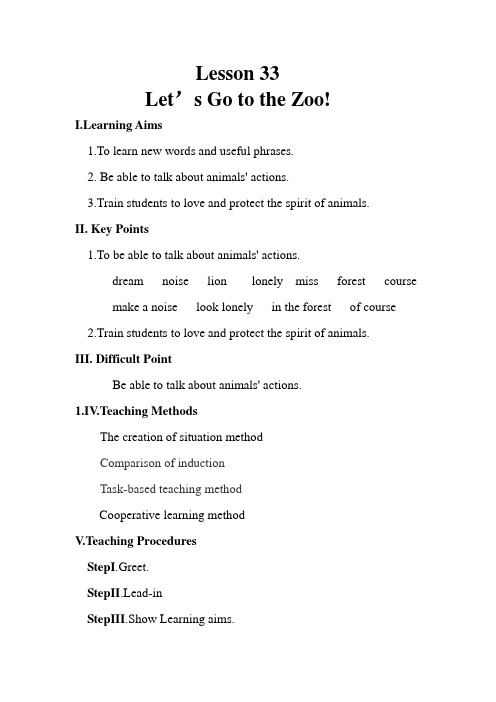
Lesson 33Let’s Go to the Zoo!I.Learning Aims1.To learn new words and useful phrases.2. Be able to talk about animals' actions.3.Train students to love and protect the spirit of animals.II. Key Points1.To be able to talk about animals' actions.dream noise lion lonely miss forest coursemake a noise look lonely in the forest of course 2.Train students to love and protect the spirit of animals.III. Difficult PointBe able to talk about animals' actions.1.IV.Teaching MethodsThe creation of situation methodComparison of inductionTask-based teaching methodCooperative learning methodV.Teaching ProceduresStepI.Greet.StepII.Lead-inStepIII.Show Learning aims.StepIV.New wordsStepV.Listening(Listen to the tape and fill in the blanks.)Look ! The monkey are eating ________. The tiger ___ _____ meat .Here is an elephant. He is ______.Look at the lion!He looks ______.He is missing the forest.StepVI.Reading1.What does the panda look like?2.What is the tiger eating?3.Is the lion missing the forest?StepVII. Find Some Sentences1.Are they eating donuts?2.They are eating donuts?3.The tiger is eating meat.4.Is he sleeping?5.He is dreaming.6.They are making noises.7.They are singing.8.May be he is missing the forest.nguage Points1.现在进行时2.noise3.alonelonelyStepIX.PairworkA:Look at pandas.Are they playing?B:Yes,they are.They are interesting.A:What animal do you like best?B:I like bear.A:Oh.Look over there .The bear is dancing.B:Great! Let's go to over there.I want to see another animals.A:OK.Let's go!StepX.Exercises1.The little elephant ____ under the tree.A.dreamingB.is dreamingC.is dreamD.dream2.----What is the monkey doing? ----He _____.A.eating a bananaB.eat a bananaC.is eating a banana3.His grandparents live ____ in a small house,but they don’tfeel______.A.lonely,aloneB.alone,lonelyC.lonely,lonelyD.alone,alone4.Stop making so much _____ .The children are sleeping.A.voiceB.noiseC.voiceStepXI.Homework1.My Favourite Animal(Group A & B).要求:(1).为什么喜欢这种动物(2) .这种动物有什么习性(3).这种动物喜欢什么食物(4).不少于80个单词2.Memorize language points.(Group B,C)3.Finish off the exercise book.(Group A,B,C)板书设计。
冀教版-英语-七上-第33课 Let's Go to the Zoo! 教案
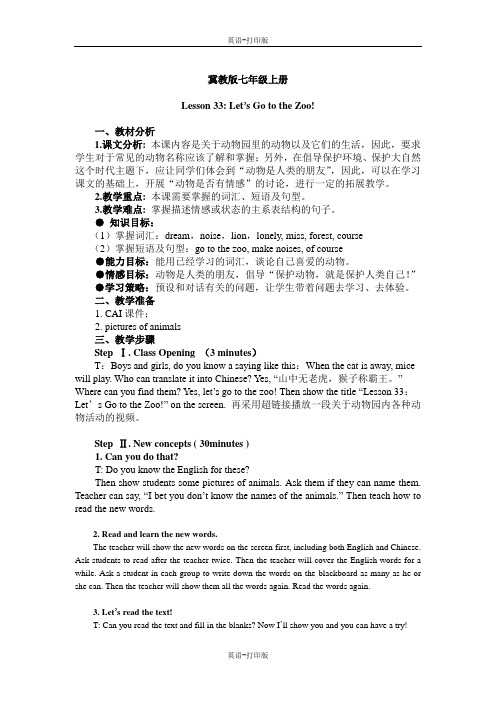
冀教版七年级上册Lesson 33: Let’s Go to the Zoo!一、教材分析1.课文分析: 本课内容是关于动物园里的动物以及它们的生活,因此,要求学生对于常见的动物名称应该了解和掌握;另外,在倡导保护环境、保护大自然这个时代主题下,应让同学们体会到“动物是人类的朋友”,因此,可以在学习课文的基础上,开展“动物是否有情感”的讨论,进行一定的拓展教学。
2.教学重点:本课需要掌握的词汇、短语及句型。
3.教学难点: 掌握描述情感或状态的主系表结构的句子。
●知识目标:(1)掌握词汇:dream,noise,lion,lonely, miss, forest, course(2)掌握短语及句型:go to the zoo, make noises, of course●能力目标:能用已经学习的词汇,谈论自己喜爱的动物。
●情感目标:动物是人类的朋友,倡导“保护动物,就是保护人类自己!”●学习策略:预设和对话有关的问题,让学生带着问题去学习、去体验。
二、教学准备1. CAI课件;2. pictures of animals三、教学步骤StepⅠ. Class Opening (3 minutes)T:Boys and girls, do you know a saying like this:When the cat is away, mice will play. Who can translate it into Chinese? Yes, “山中无老虎,猴子称霸王。
”Where can you find them? Yes, let’s go to the zoo! Then show the title “Lesson 33:Let’s Go to the Zoo!” on the screen. 再采用超链接播放一段关于动物园内各种动物活动的视频。
StepⅡ. New concepts ( 30minutes )1. Can you do that?T: Do you know the English for these?Then show students some pictures of animals. Ask them if they can name them. Teacher can say, “I bet you don’t know the names of the animals.” Then teach how to read the new words.2. Read and learn the new words.The teacher will show the new words on the screen first, including both English and Chinese. Ask students to read after the teacher twice. Then the teacher will cover the English words for a while. Ask a student in each group to write down the words on the blackboard as many as he or she can. Then the teacher will show them all the words again. Read the words again.3. Let’s read the text!T: Can you read the text and fill in the blanks? Now I’ll show you and you can have a try!教师引导学生先听一遍课文内容,然后再播放一遍,让学生根据听到的内容去填空。
Unit6Lesson33教案冀教版英语七年级上册
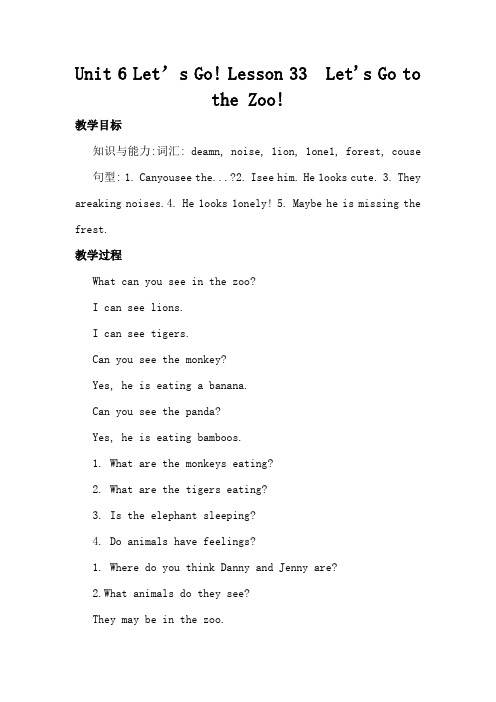
Unit 6 Let’s Go! Lesson 33 Let's Go tothe Zoo!教学目标知识与能力:词汇: deamn, noise, 1ion, 1one1, forest, couse 句型: 1. Canyousee the...?2. Isee him. He 1ooks cute. 3. They areaking noises.4. He 1ooks 1onely! 5. Maybe he is missing the frest.教学过程What can you see in the zoo?I can see lions.I can see tigers.Can you see the monkey?Yes, he is eating a banana.Can you see the panda?Yes, he is eating bamboos.1. What are the monkeys eating?2. What are the tigers eating?3. Is the elephant sleeping?4. Do animals have feelings?1. Where do you think Danny and Jenny are?2.What animals do they see?They may be in the zoo.They see monkeys, the panda, the tiger,the elephant, birds, the lion.Read the lesson and circle the correct words.1. The tiger is (hungry / tired / sad).2. The lion is (lonely / sick/ hungry).3. The panda is (lonely / happy / cute).4. The birds are (quiet / happy / hungry).5. The elephant is (eating / dreaming / singing).1. What are the monkeys eating?2. Is the panda eating meat?3. Which animal is eating meat?4. What is the elephant doing?1. What are the birds doing?2. How is the lion?Read the passage and find the phrases. Put them into Chinese. go to the zoolook cute/ lonelyover theremake noiseslook atof courseI dream (V. 做梦) a good dream ( n. 梦 ). My friends andI e to a zoo. There are many animals there. We see monkeys, tigers, lions( 狮子) , elephants, pandas, birds and so on. A little elephant is sleeping. He is dreaming. Its mother is looking after ( 照顾 )him. A tiger is eating meat. There are many monkeys playing there . Two monkeys are hugging ( 拥抱 ).A monkey is eating bananas. A panda is cute. He likes eating bamboos ( 竹子 ). Look at the lion .He looks lonely( 孤独). Maybe he is missing the forest ( 森林 ). Where are the birds ? Oh , they are over there. We can see parrots(鹦鹉). A nice parrot looks like a waiter . He says “Hello” to us . We have a good time .Listen and discuss the text, then answer the questions.1.How many animals are there in the zoo?2.What are they ?3.What are they doing?。
冀教版-英语-七上--5单元 Family and Home(第33课教案)
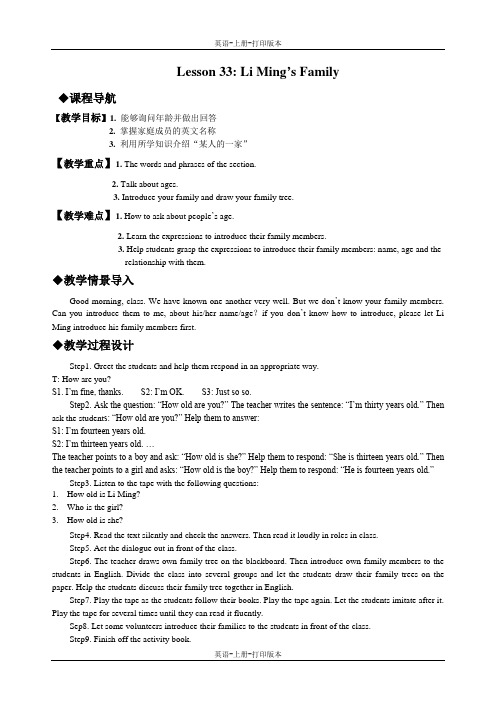
Lesson 33: Li Ming’s Family◆课程导航【教学目标】1. 能够询问年龄并做出回答2. 掌握家庭成员的英文名称3.利用所学知识介绍“某人的一家”【教学重点】1. The words and phrases of the section.2. Talk about ages.3. Introduce your family and draw your family tree.【教学难点】1. How to ask about people’s age.2. Learn the expressions to introduce their family members.3. Help students grasp the expressions to introduce their family members: name, age and therelationship with them.◆教学情景导入Good morning, class. We have known one another very well. But we don’t know your family members. Can you introduce them to me, about his/her name/age?if you don’t know how to introduce, please let Li Ming introduce his family members first.◆教学过程设计Step1. Greet the students and help them respond in an appropriate way.T: How are you?S1. I’m fine, thanks. S2: I’m OK. S3: Just so so.Step2. Ask the question: “How old are you?” The teacher writes the sentence: “I’m thirty years old.” Then ask the student s: “How old are you?” Help them to answer:S1: I’m fourteen years old.S2: I’m thirteen years old. …The teacher points to a boy and ask: “How old is she?” Help them to respond: “She is thirteen years old.” Then the teacher points to a girl and asks: “How old is the boy?” Help them to respond: “He is fourteen years old.”Step3. Listen to the tape with the following questions:1.How old is Li Ming?2.Who is the girl?3.How old is she?Step4. Read the text silently and check the answers. Then read it loudly in roles in class.Step5. Act the dialogue out in front of the class.Step6. The teacher draws own family tree on the blackboard. Then introduce own family members to the students in English. Divide the class into several groups and let the students draw their family trees on the paper. Help the students discuss their family tree together in English.Step7. Play the tape as the students follow their books. Play the tape again. Let the students imitate after it. Play the tape for several times until they can read it fluently.Sep8. Let some volunteers introduce their families to the students in front of the class.Step9. Finish off the activity book.◆课堂板书设计Lesson 33: Li Ming’s Familyfather, mother, young, family, daughter, son, brother, sister, year, grandfather, grandmother, aunt, uncle, cousin, loveHow old are you?I am ____ (years old).How old is she / he?She / He is _____ (years old).◆作业1. Finish the remaining exercises in the activity book.2. Preview the next reading in the student book.3. Write a short passage about your family.●教学反思通过讲授这一课,我发现同学们课外阅读很少,了解的知识不够,我觉得适当的课外阅读是很有必要的。
初中冀教版英语七年级上册【教学设计】Unit 6 Lesson 33
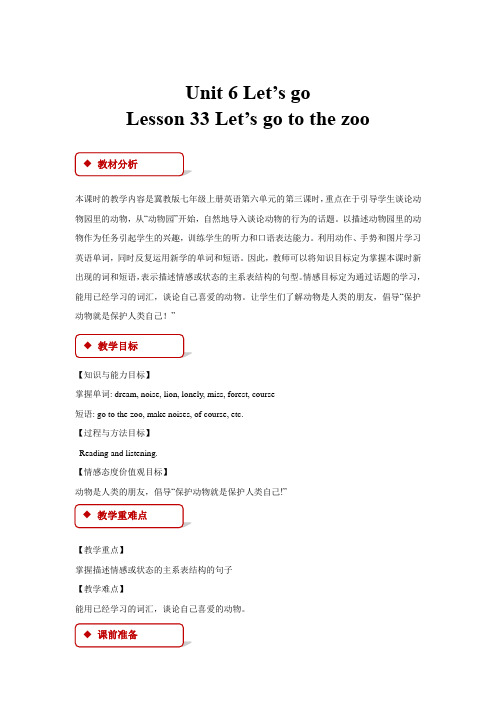
Unit 6 Let’s goLesson 33 Let’s go to the zoo本课时的教学内容是冀教版七年级上册英语第六单元的第三课时,重点在于引导学生谈论动物园里的动物,从“动物园”开始,自然地导入谈论动物的行为的话题。
以描述动物园里的动物作为任务引起学生的兴趣,训练学生的听力和口语表达能力。
利用动作、手势和图片学习英语单词,同时反复运用新学的单词和短语。
因此,教师可以将知识目标定为掌握本课时新出现的词和短语,表示描述情感或状态的主系表结构的句型。
情感目标定为通过话题的学习,能用已经学习的词汇,谈论自己喜爱的动物。
让学生们了解动物是人类的朋友,倡导“保护动物就是保护人类自己!”【知识与能力目标】掌握单词: dream, noise, lion, lonely, miss, forest, course短语: go to the zoo, make noises, of course, etc.【过程与方法目标】Reading and listening.【情感态度价值观目标】动物是人类的朋友,倡导“保护动物就是保护人类自己!”【教学重点】掌握描述情感或状态的主系表结构的句子【教学难点】能用已经学习的词汇,谈论自己喜爱的动物。
图片,PPTStep 1. Lead inLeading in 【情景1】Show pictures of the animals in the zoo. Point to the pictures. Ask the students questions.T: Where are the animals?Ss: They are in the zoo.T: What is the monkey doing?S1: He is eating bananas.T: Where is the monkey?S2: He is on the tree.T: What is the lion doing?S3: He is drinking water.T: Is he hungry?S4: Yes, I think so.…【设计意图】本课内容和动物园里的动物有关,故在Class Opening 阶段以“看图画,说一说”的形式,对相关的词汇、短语和句型进行复习并活跃课堂气氛。
冀教版七年级英语上册教案Unit 6 Lesson 33
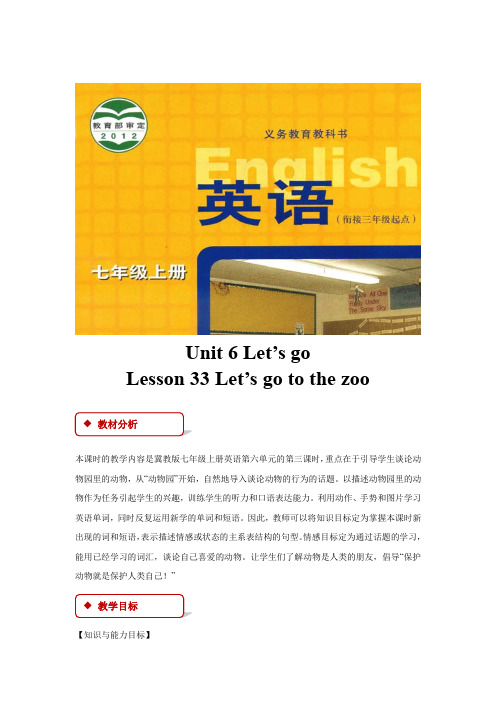
Unit 6 Let’s goLesson 33 Let’s go to the zoo本课时的教学内容是冀教版七年级上册英语第六单元的第三课时,重点在于引导学生谈论动物园里的动物,从“动物园”开始,自然地导入谈论动物的行为的话题。
以描述动物园里的动物作为任务引起学生的兴趣,训练学生的听力和口语表达能力。
利用动作、手势和图片学习英语单词,同时反复运用新学的单词和短语。
因此,教师可以将知识目标定为掌握本课时新出现的词和短语,表示描述情感或状态的主系表结构的句型。
情感目标定为通过话题的学习,能用已经学习的词汇,谈论自己喜爱的动物。
让学生们了解动物是人类的朋友,倡导“保护动物就是保护人类自己!”【知识与能力目标】掌握单词: dream, noise, lion, lonely, miss, forest, course短语: go to the zoo, make noises, of course, etc.【过程与方法目标】Reading and listening.【情感态度价值观目标】动物是人类的朋友,倡导“保护动物就是保护人类自己!”【教学重点】掌握描述情感或状态的主系表结构的句子【教学难点】能用已经学习的词汇,谈论自己喜爱的动物。
图片,PPTStep 1. Lead inLeading in 【情景1】Show pictures of the animals in the zoo. Point to the pictures. Ask the students questions. T: Where are the animals?Ss: They are in the zoo.T: What is the monkey doing?S1: He is eating bananas.T: Where is the monkey?S2: He is on the tree.T: What is the lion doing?S3: He is drinking water.T: Is he hungry?S4: Yes, I think so.…【设计意图】本课内容和动物园里的动物有关,故在Class Opening 阶段以“看图画,说一说”的形式,对相关的词汇、短语和句型进行复习并活跃课堂气氛。
冀教版英语七上Unit 6《Lesson 33 Let’s Go to the Zoo!》说课稿
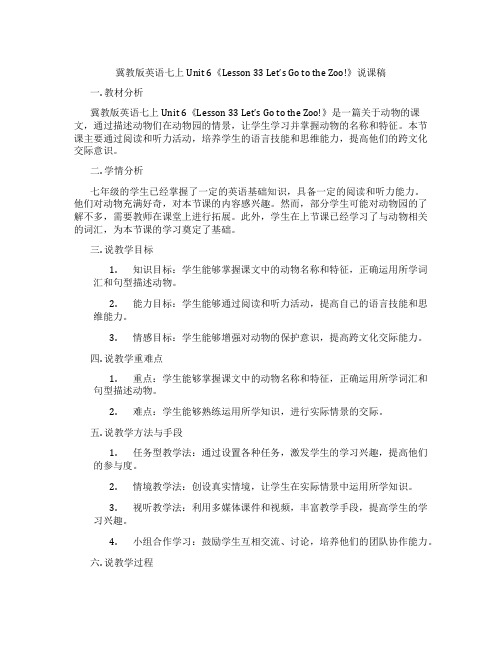
冀教版英语七上Unit 6《Lesson 33 Let’s Go to the Zoo!》说课稿一. 教材分析冀教版英语七上Unit 6《Lesson 33 Let’s Go to the Zoo!》是一篇关于动物的课文,通过描述动物们在动物园的情景,让学生学习并掌握动物的名称和特征。
本节课主要通过阅读和听力活动,培养学生的语言技能和思维能力,提高他们的跨文化交际意识。
二. 学情分析七年级的学生已经掌握了一定的英语基础知识,具备一定的阅读和听力能力。
他们对动物充满好奇,对本节课的内容感兴趣。
然而,部分学生可能对动物园的了解不多,需要教师在课堂上进行拓展。
此外,学生在上节课已经学习了与动物相关的词汇,为本节课的学习奠定了基础。
三. 说教学目标1.知识目标:学生能够掌握课文中的动物名称和特征,正确运用所学词汇和句型描述动物。
2.能力目标:学生能够通过阅读和听力活动,提高自己的语言技能和思维能力。
3.情感目标:学生能够增强对动物的保护意识,提高跨文化交际能力。
四. 说教学重难点1.重点:学生能够掌握课文中的动物名称和特征,正确运用所学词汇和句型描述动物。
2.难点:学生能够熟练运用所学知识,进行实际情景的交际。
五. 说教学方法与手段1.任务型教学法:通过设置各种任务,激发学生的学习兴趣,提高他们的参与度。
2.情境教学法:创设真实情境,让学生在实际情景中运用所学知识。
3.视听教学法:利用多媒体课件和视频,丰富教学手段,提高学生的学习兴趣。
4.小组合作学习:鼓励学生互相交流、讨论,培养他们的团队协作能力。
六. 说教学过程1.导入:教师通过提问,引导学生谈论他们喜欢的动物,激发学生的学习兴趣。
2.阅读理解:学生阅读课文,回答相关问题,了解动物的名称和特征。
3.听力训练:学生听课文录音,完成听力练习,提高听力技能。
4.词汇学习:教师引导学生学习课文中的新词汇,巩固已学知识。
5.句型练习:学生运用所学词汇和句型,描述自己喜欢的动物。
翼教七上Lesson33seasonsandweather教案
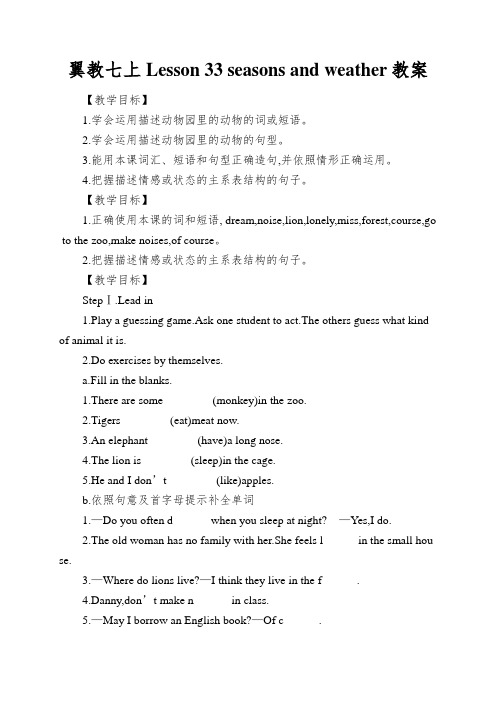
翼教七上Lesson 33 seasons and weather教案【教学目标】1.学会运用描述动物园里的动物的词或短语。
2.学会运用描述动物园里的动物的句型。
3.能用本课词汇、短语和句型正确造句,并依照情形正确运用。
4.把握描述情感或状态的主系表结构的句子。
【教学目标】1.正确使用本课的词和短语, dream,noise,lion,lonely,miss,forest,course,go to the zoo,make noises,of course。
2.把握描述情感或状态的主系表结构的句子。
【教学目标】StepⅠ.Lead in1.Play a guessing game.Ask one student to act.The others guess what kind of animal it is.2.Do exercises by themselves.a.Fill in the blanks.1.There are some (monkey)in the zoo.2.Tigers (eat)meat now.3.An elephant (have)a long nose.4.The lion is (sleep)in the cage.5.He and I don’t (like)apples.b.依照句意及首字母提示补全单词1.—Do you often d when you sleep at night?—Yes,I do.2.The old woman has no family with her.She feels l in the small hou se.3.—Where do lions live?—I think they live in the f.4.Danny,don’t make n in class.5.—May I borrow an English book?—Of c.c.从方框中选出相对应的答语1.Are the monkeys eating donuts?2.What do lions eat?3.Where do animals live?4.How does the lion feel?5.Do you like to watch animals?A.It feels hungry and lonely.B.No,they aren’t.C.Yes,I’d love to.D.They live in the zoo.E.They eat meat.StepⅡ.Presentation1.The teacher should teach the new words and phrases in this part.2.The students work in pairs.Try to make sentences with the new words and expressions.StepⅢ.Listening1.Listen to the passage and fill in the blanks.(1)The monkeys are eating .(2)The tiger is eating .(3)The are making noises.(4)The looks lonely.2.Listen to the passage and ask the students to imitate it.StepⅣ.Reading1.The teacher asks the class to read aloud and finish Exercise 2 in Let’s D o It!2.Read,ask and answer questions.Read the text first,then ask at least 3 questions.3.Read and find the key points.1.Monkeys!monkey的复数是monkeys。
- 1、下载文档前请自行甄别文档内容的完整性,平台不提供额外的编辑、内容补充、找答案等附加服务。
- 2、"仅部分预览"的文档,不可在线预览部分如存在完整性等问题,可反馈申请退款(可完整预览的文档不适用该条件!)。
- 3、如文档侵犯您的权益,请联系客服反馈,我们会尽快为您处理(人工客服工作时间:9:00-18:30)。
Lesson 33 Let’s go to the zoo(教学设计)桑园第一初级中学孙明媚2015.1Lesson 33 Let’s go to the zooPart One: Analysis of the Teaching Materials(教材分析)(一) Lesson type (课型)( A new Lesson)(二) Status and function (本课在教学中的地位).This is a listening lesson. The lesson is a bout what the animals are doing..It is helpful for the Ss to learn about animals and protect them..(三)Teaching aims (教学目标)1、Knowledge objects (认知目标).A) Enable the Ss to remember the words :dream, noise, lion, lonely, miss, forest, courseB) Get the Ss to be familiar with present continous tense: What is the elephant doing?He is dreaming. The birds are singing. Is the panda eating?C) Help Ss to know more about the animals2、Ability objects (智能目标).oral-speaking abilities.A) To improve the Ss’ B) To cultivate their ability to discover, analyze and solve problems.3、Moral objects (德育目标).awareness of protecting animals.To improve the Ss’ (四) Teaching Important Points (教学重点)1) Master the words and phrases.2) Talk about present continous tense(五) Teaching Difficult Points(教学难点)awareness of protecting animals.How to improve the Ss’ Part Two:Teaching methods (教法)1. Multi-media teaching.It can help the students be interested in the lesson and learnthe lesson happily and easily.2、Encouragement and praise.3. “Task-based” t eaching method.“Task-based” language teaching is an effective and advanced teaching approach. It’s widely used in many different countries.Part Three: Learning methods (学法).1. Teach Ss how to be successful language learners.2. Get the Ss to form good learning habits. Such as: Co-operation and competition----Students cooperateand compete with each other by working in groups.Part Four: Teaching Aids(教具)Multi-media computer, courseware(课件), the students’pictures, a tape recorder,Part Five: Analysis of the students (学生分析)The students are in Grade Seven now, and they have some interests of learning and s peaking English, they are willing to co-operate and communicate with others in class, especeasy for them to learn the lesson ially this lesson is related to their daily life. I think it’sand they will take an active part in the activities in class.Part Six: Teaching procedures(教学过程)Step I. Greetings.Step II.Show time“ Ask the way” and “ At Ask some students to come to the blackboard to say and act the scenesthe supermarket”设计意图:让学生通过表演的形式复习上两节课学习的内容,形式活泼,学生喜欢参与,在轻松的氛围中达到了复习的效果。
Step III. Leading in.In lesson 31 Danny and Jenny go to the bookstore.In Lesson 32, Li Ming and his mum go to the supermarket.边说边展示图片) Today they want to see some animals, where can they go? (Ss: They can go to the zoo.T: Yes, now let’s learn a new lesson. Lesson 33: Let’s go to the zoo.(板书):lesson 33 Let’s go to the zoo.(设计意图:图片导入,激起学生强烈的求知欲望)Step IV. Guessing gameT: Please look at the blackboard. Read and guess.1. It lives in a forest. It eats meat. It looks like a big cat.( tiger )2. It lives in a tree. It eats bananas. It has a long tail.( monkey )3. It’s a big animal. It eats meat. It is the king of the jungle.( lion )4. It has a long nose. It has strong legs and big ears. ( elephant )5. It is white and black. It looks cute. It likes to eat bamboo. ( panda )设计意图:通过猜谜游戏,激发学生兴趣,快速进入文章。
为讲解课文做铺垫。
StepV Listening.Listen to the tape then tell true or false.1. The monkeys are eating donuts. ( F )2. The panda looks cute. ( T )3. The tiger is hungry.(T )4. The elephant isn’t dreaming.(T )5.Jenny thinks the birds are making noises.( F )6. The animals don’t have feelings.( F )设计意图:通过简单的几个听力题目,学生可以快速的感知文章,了解文章的主要内容,锻炼了学生的听力水平。
Step VI PresentationT: How many animals can you see in th picture? ( Show some pictures and ask)Ss: Six.T: What are they?Ss: They are monkeys, tigers, lions, pandas, birds and elephants.T: Yes. Now let’s look at what they are doing?T: What is the elephant doing?Ss: He is dreaming.( 边说边板书此句,领读)T: What does the panda look like?Ss: It looks cute.T: What is the panda doing?Ss: It is sleeping.T: Look at the monkeys. Are they eating donuts?Ss: No, they aren’t.T: What are they doing?Ss: They are eating bananas.T: What are the tigers doing?Ss:They are eating meat.T: Maybe They are hungry.T:Look at the lion.Is he sad?T and Ss: The lion looks lonely.(边说边板书此句,然后讲解lonely 和alone 的区别) lonely: 孤独的(有感情色彩,指人孤独寂寞)alone: 单独的,一个人(没有感情色彩)eg. He lives alone, but he doesn’t feel lonely.T: Maybe he is missing the forest. (边说边板书此句,领读)T:What are the birds doing? Are they making noises?(边说边板书,领读)Ss: They are singing happily.设计意图:通过师生问答,老师讲解领读,学生对新单词,重点句都有了深刻的记忆。
